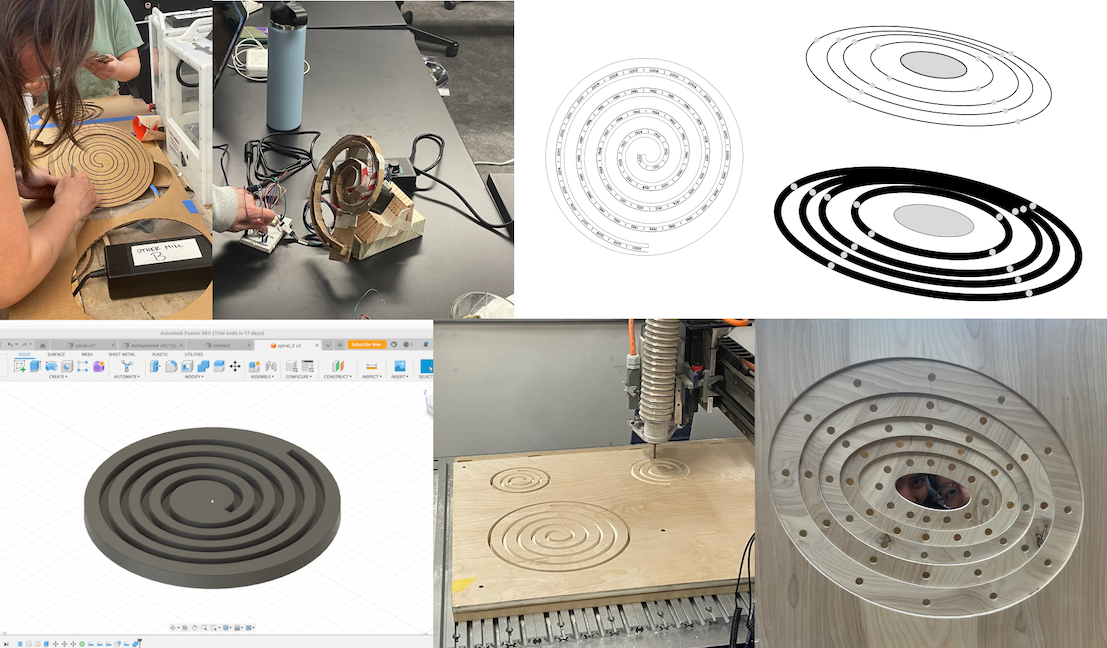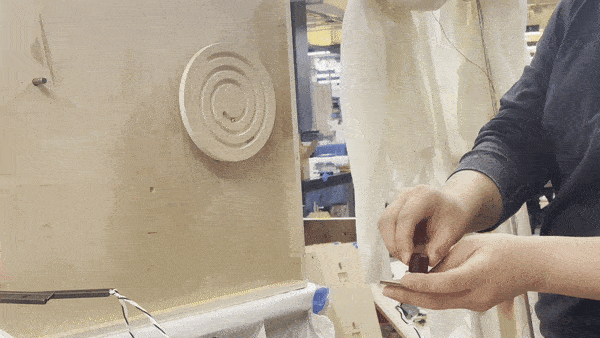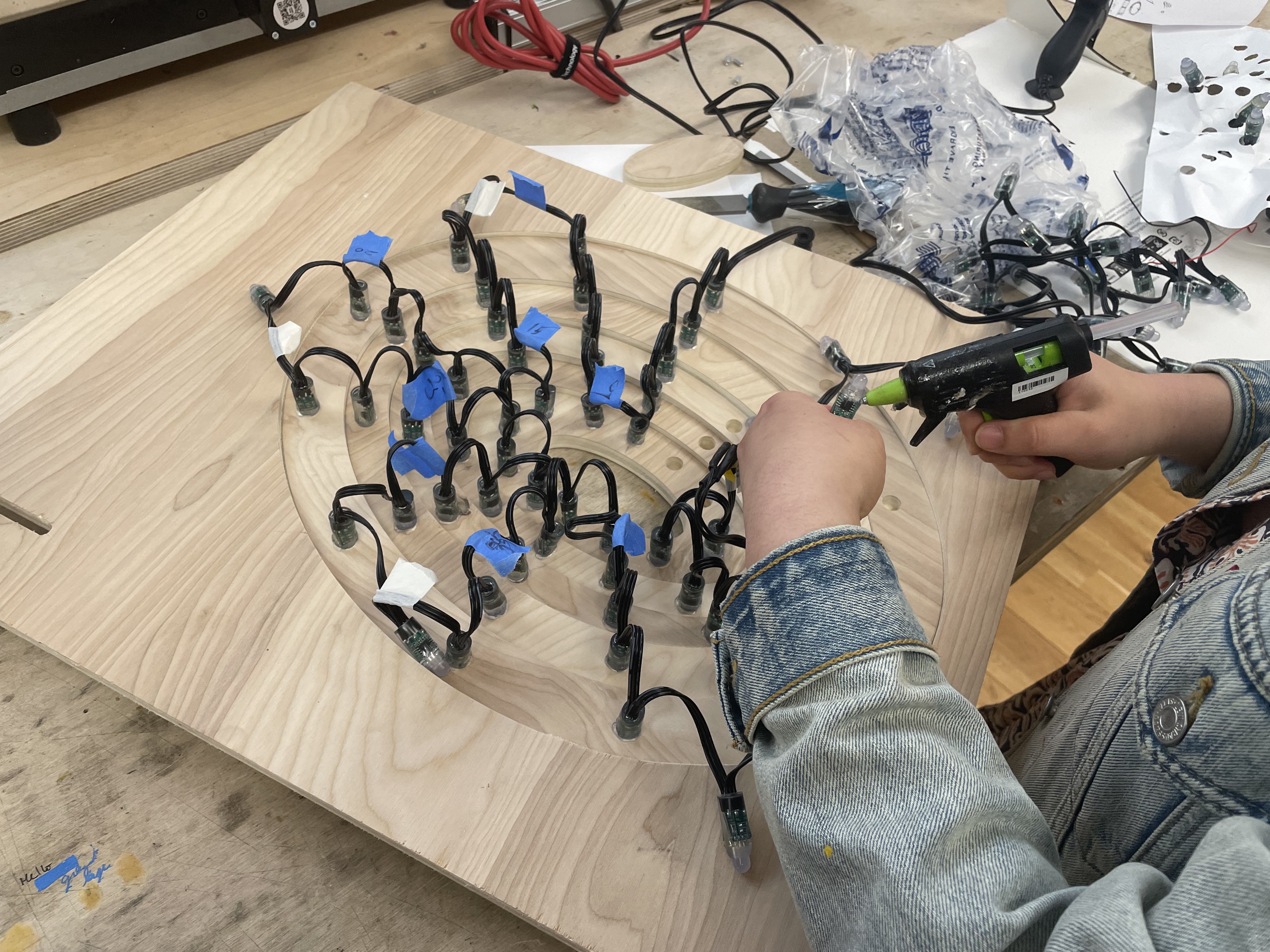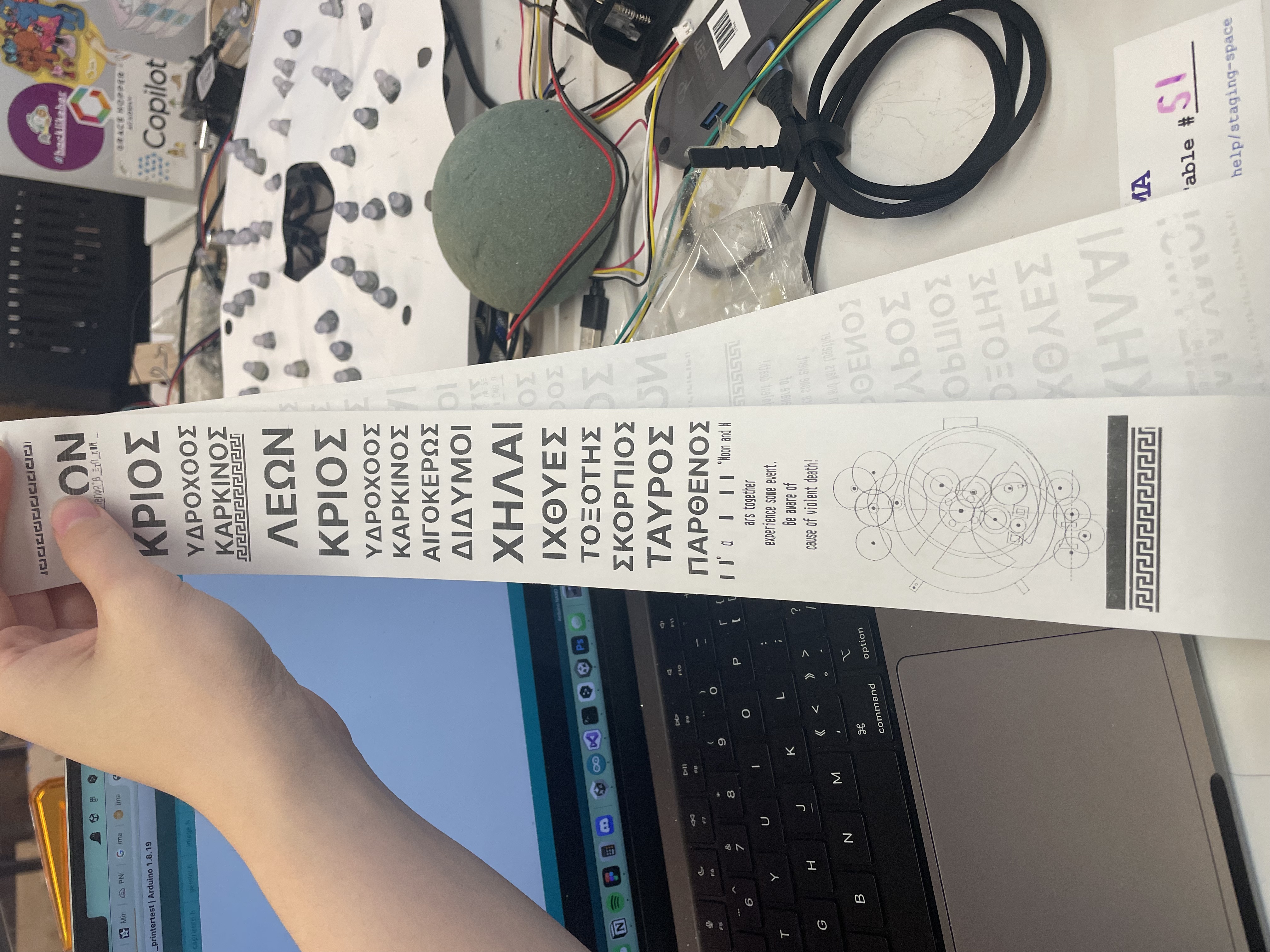Fated Time: Recreation of Antikythera Mechanism

#interactive-installation #museum-design #playful-design
| Project Goal
Collaborated with Dr. Alexander Jones from the Institute for the Study of the Ancient World at NYU, the project aims to turn the Antikythera Mechanism (~100 BCE) into a playful design for a museum setting.
Collaborated with Dr. Alexander Jones from the Institute for the Study of the Ancient World at NYU, the project aims to turn the Antikythera Mechanism (~100 BCE) into a playful design for a museum setting.
| Project Outcome
An experience made up of a series of installations. The core is a 29x24x28 inch interactive installation, the rest consists of an AR interactive booth, an explanation of the AM itself and further elaboration of the installation.
An experience made up of a series of installations. The core is a 29x24x28 inch interactive installation, the rest consists of an AR interactive booth, an explanation of the AM itself and further elaboration of the installation.
The Antikythera Mechanism is often regarded as a 2000-year-old analog computer. It uses 30+ gears to mechanically calculate a repeatable conversion from calendars to planetary alignments. There are a few scholarly hypotheses for its purposes. A plausible one is that it can be used to aid astrological readings in a visual way.
Fated Time is an interpretation of the AM that illustrates the function of horoscopes. Participants are invited to get a 2000-year-old astrological reading by inputting their birthdays, and then observing both the mechanism and the cosmo at work.
Exhibition
NYU ITP, Spring 2024
Long Island Maker Fair, June 2024
NYU ITP, Spring 2024
Long Island Maker Fair, June 2024
Role
Physical Computing + AR Development, in collaboration with Una Zhang, Jenny Lee, Alfonssette Medina
Physical Computing + AR Development, in collaboration with Una Zhang, Jenny Lee, Alfonssette Medina
Toolkit
Physical Computing (Arduino Uno, Nano, IoT) | Digital Fabrication (Laser cut, CNC, Metal cut) | Python | Unity | Figma | Adobe Suite
Physical Computing (Arduino Uno, Nano, IoT) | Digital Fabrication (Laser cut, CNC, Metal cut) | Python | Unity | Figma | Adobe Suite
👉 [jump to 02. Ideation] [jump to 03. Development]
01. Conceptual Design
01-1 Content Research
01-1.1 Secondary Research
We began by conducting secondary research through books and online databases, including resources from the international research group. Several key points intrigued us:
01-1.2 Astrology Research
Our research revealed that astrological readings from thousands of years ago follow a structure strikingly similar to modern readings. We were particularly intrigued by the detailed ways of interpreting life events, especially the various forms of death described by ancient astrologers.
01-1.3 Design Research
One of our main challenges was determining how to invite users to interact with the installation and ignite their curiosity. Initially, we considered following the typical museum approach—presenting information upfront and then allowing interaction. However, we observed that people were naturally drawn to playing with our prototype first and tended to ask questions afterward. This led us to the decision to avoid front-loading information. Instead, we chose to guide users directly into the interactive experience by providing an astrological reading based on their birthday, a detail many people find personally engaging. This approach allowed individuals to explore human history, technology, and cultural beliefs through a personal lens.
We began by conducting secondary research through books and online databases, including resources from the international research group. Several key points intrigued us:
- The technical intricacy of the Antikythera Mechanism
- The multiple calendars embedded within the mechanism, which reflected the social and cultural norms of the time
- The large-scale, long-term collaboration across regions that made the creation of such a complex mechanism possible
01-1.2 Astrology Research
Our research revealed that astrological readings from thousands of years ago follow a structure strikingly similar to modern readings. We were particularly intrigued by the detailed ways of interpreting life events, especially the various forms of death described by ancient astrologers.
01-1.3 Design Research
One of our main challenges was determining how to invite users to interact with the installation and ignite their curiosity. Initially, we considered following the typical museum approach—presenting information upfront and then allowing interaction. However, we observed that people were naturally drawn to playing with our prototype first and tended to ask questions afterward. This led us to the decision to avoid front-loading information. Instead, we chose to guide users directly into the interactive experience by providing an astrological reading based on their birthday, a detail many people find personally engaging. This approach allowed individuals to explore human history, technology, and cultural beliefs through a personal lens.
Group photo (left to right): Una Zhang, Joyce Zheng, Jenny Lee, Dr. Alexander Jones, Alfonssette Medina
01-2 Design Decisions
We divided the interaction into three key parts to convey different layers of information:
- Calendar Design: We highlighted the unique use of spiral shapes on the mechanism's calendar face. Research suggests that this spiral design was likely employed to fit over 200 values on a single face. By emphasizing this, we challenge the common assumption that calendars must be circular, encouraging users to think about different ways of conceptualizing time.
- Mechanical Intricacies: Although we acknowledged the mechanism’s technical complexity, we chose not to prioritize this area since it has been extensively covered in other popular resources.
- Astrological Connection: The interaction concludes with a printout of an astrological reading from Vettius Valens, compiled in the 2nd century CE. We used the original Greek spelling of astrological signs to evoke a sense of authenticity and invited users to explore more about their sign through an AR experience, further bridging the gap between ancient cultural practices and modern interactive technology.
This research phase was integral in shaping our final installation, combining history, technology, and interactive design to offer an educational yet deeply personal experience for each user.
01-3 Main Message -> Proposal
Based on our conversation & furthe research, we sorted out on the main ideas we want to convey:
- We humans have always been curious of predicting time and exploring the cosmos.
- This desire has been a driving force in the sharing of knowledge and the development of technology since the beginning of civilizations.
According to these ideas, we came up with three potential proposals we would like to develop further.

Horoscope
The horoscope will be a vertical installation piece - equivalent to a person’s height. Users need to use
an analog, physical control to interact with a digital simulation showing how the celestial bodies are positioned during the time of your birth, and then they will get an output from the thermal printer with your fortune
Goals:
The horoscope will be a vertical installation piece - equivalent to a person’s height. Users need to use
an analog, physical control to interact with a digital simulation showing how the celestial bodies are positioned during the time of your birth, and then they will get an output from the thermal printer with your fortune
Goals:
- learn about the history of astrology and AM by hands-on experience
- Show the interconnectedness of human experience across space and time

RPG (Role-Playing Game)
RPG looks like an arcade, and users will be able to interact with ancient greek people through different stories and plots to learn using AM to calculate time and many different cultural and astrological phenomena.
Goals:
RPG looks like an arcade, and users will be able to interact with ancient greek people through different stories and plots to learn using AM to calculate time and many different cultural and astrological phenomena.
Goals:
- Participants get a hands-on feeling of “operating” the Antikythera Mechanism
- They learn how Greeks perceive and use astrological events and prediction

Indiana Jones
Users will assemble the AM through different pieces to learn about the structure and different functions of it. When they successfully assemble it, they’ll get a print-out talking about the AM.
Goals:
Users will assemble the AM through different pieces to learn about the structure and different functions of it. When they successfully assemble it, they’ll get a print-out talking about the AM.
Goals:
- Experience a simulated archaeological excavation
- Learn about the ancient analog computer and its functions
- Feel the satisfaction of collaborating and unlocking a puzzle
02. Ideation
02-1 Final Proposal
We received a lot of feedbacks from Dr. Jones and peers after presenting the three ideas.
- People would be more into the physical input, mimicing the original mechanism
- People love horoscope! Humans have always been interesetd in their futures.
- Think about different layers of audience. When one user operates, what are others doing?
- Consider the cost, from time, material to human labor.
- People would be more into the physical input, mimicing the original mechanism
- People love horoscope! Humans have always been interesetd in their futures.
- Think about different layers of audience. When one user operates, what are others doing?
- Consider the cost, from time, material to human labor.

The physical dial we refer to
Combining suggestions from various parties as well as our initial interests and starting points, we finally decided to take the idea of the horoscope as a blueprint and expand on it further.
02-2 Storyboard
The finalized experience is divided into three sections, as shown in the user flow below. In order to include a sufficient amount of information about AM throughout the experience without overloading it, we tried to give the audience different guidelines at different stages of the process.

02-3 Project Planning
After settling down on the user flow, we started to plan out the implementation, which including the real-size of the project, physical design choices (material, paint, physical computing components) and virtuals (font type, graphics, interactions). More experiments will be elaborated in the next section.

Overview sketch

System Diagram

Budget Planning Spreadsheet
03. Development
After rounds of discussion, we created the diagram of each parts we need to complete.

03-1 Fabrication
We built the whole installation from 0. Choosing wood/metal materials, modeling, CNC, laser-cutting, testing paints, and then assemble everything together.




03-2 Physical Computing
For the input section, we used the rotary encoder to detect the angle users have rotate, then the data will be sent into the python program, where it was decoded as the corresponding year/month/date.
 Prototype
Prototype Fabrication
Fabrication Connected Circuit
Connected Circuit
Screenshot - light section

Screenshot - thermal printer section

Screenshot - python program
Star panel at the back side:






03-3 AR Development
The AR section is a continuous one following the thermal printout. As there’s an ancient-Greek text pattern on the ticket, we want the audience to be able to experience the decoding by themselves through external tools.
All the ancient greeks is stored as target in Vuforia, which would trigger related star sign information when users scan them.


In-unity target testing

Final design
04. Future Opportunities
Due to the scope of time a lot of our design choices could be improved.
- material: the boards we are using are very heavy & over 1cm thick, which makes it very difficult to get the whole cabinet to fit together.
- hardware: a lot of physical computing hardware components are easy to burnt/be damaged. More than that, the rotary encoders we use to get the value from the audience isn’t accurate all the time due to the hardware precision. We are still looking for a better solution.
- inclusivity: in the middle stage of the experience, we invite the audience to crouch down to look through small holes at the gears inside the box. This action is not friendly enough for many people, so it is best that we provide small holes/aids in different positions to ensure the accessibility of the experience
- project-planning: we stayed up so many nights... a better planning would definitely help everything.
Along with the Spring Show at ITP, we also participated in the Long Island Maker Fair to showcase our installation. We figured that people are also interested in the internal strucutre, where they find it educational and insightful.

︎︎︎[Prev]
Thank you for reading 🕰